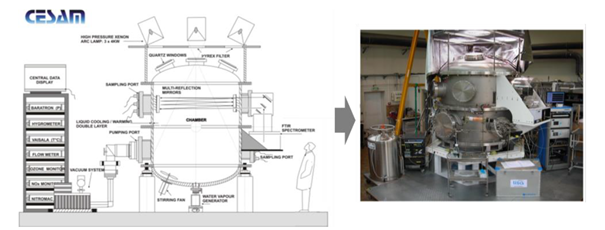CLIMDO
CLImate relevant processing of Mineral Dust by volatile Organic compounds (CLIMDO)
CLIMDO tackles the ambitious goal of advancing our knowledge of the global effect of mineral dust on climate by investigating how mineral dust interacts with important organic SOA precursor gases, glyoxal (GL) and methylglyoxal (MGL). GL and MGL both have anthropogenic and biogenic sources, but mostly result from the oxidation of isoprene (primarily by the OH radical). Both are therefore ubiquitous in the atmosphere but are particularly concentrated the Euro-Mediterranean basin and in sub-Saharan Africa. GL and MGL’s ability to undergo oligomerization, hydration, and hemi-/acetal formation can drastically alter the physical (size, shape, viscosity) and chemical (hygroscopicity, oxidation state) properties of the particles on which it adsorbs. The adsorption of GL/MGL and these subsequent reactions will likely alter the interactions of mineral dust with radiation and clouds. Therefore, dust/organic interactions will likely affect both the global SOA budget and global/regional cloud formation potential.
This research uses a combination of innovative laboratory experiments in a well-controlled and characterized environment (simulation chamber) and the development of novel modelling schemes of both the reaction mechanisms and the resulting optical properties of the mineral dust. This investigation is comprised of four main points:
1) To characterize the rate at which glyoxal/methylglyoxal uptakes onto real mineral dust samples. CLIMDO will investigate whether or not GL/MGL uptake onto dust particles is reversible or irreversible at different environmental and photolytic conditions, and the chemical processes that GL/MGL undergo on real dust aerosols. In particular, it will investigate the degree to which glyoxal undergoes oligomerization on dust particles, and in turn their degree of oxidation. All these goals serve to better our understanding of natural aerosols and the processes they undergo. This understanding can then be applied to models to improve regional and global climate modelling.
2) To investigate the effect that heterogeneous reactions have on the optical properties and hygroscopicity of the dust (therefore affecting the dust’s radiative properties). The reaction uptake and formation of monolayers on the dust particles can act to enhance or suppress the water uptake. Depending on the dust/organic system’s optical properties, the rate of radiative absorption to scattering of mineral dust can be modified. Practically no experimental data exist on these effects.
3) To model the dust system using a kinetic multi-layer model to better understand the microphysical processes of the system. The results from the first objective will be applied to the Kinetic Multi-layer models for Gas-Particle interactions and Surface and Bulk chemistry (KM-GAP/KM-SUB). This will allow for the investigation of the impact of a holistic atmospheric chemical aging process for the dust/organic system. This will yield information about the size change and temporal evolution of semi-volatile species at the surface of the particle system which is needed to bridge gaps in the understanding of multiphase chemistry and microphysics in aerosols and clouds.
4) To develop data products detailing the evolution of the chemical and optical properties of the dust system to be used in global climate models. Addressing the knowledge gaps in climate science requires that experimental and small-scale model results can be scaled to larger global climate models. The work from the first two objectives must be packaged and made available to model developers in a form that is implementable in a global model framework.
Contact LISA: P. Formenti
Financial support: PRESTIGE/EUROCHAMP-2020 (2018-2019)
Partners
E. Romanias, F. Thevenet - IMT Lille Douai
Y. Balkanski, D. Hauglustaine - LSCE
M. Shiraiwa – UCLA-Irvine


